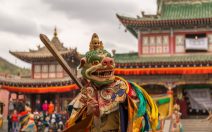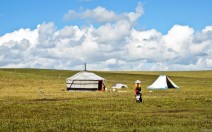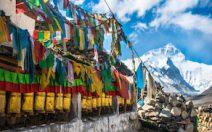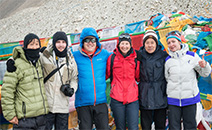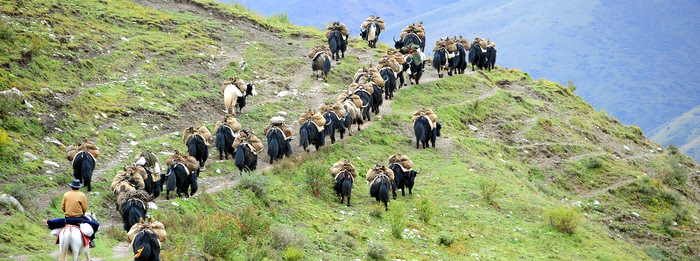We receive thousands of inquires from travelers who are frustrated and confused with the Tibet Travel info available on the Internet. Here we listed most up-to-date travel information: how to arrange a tour to Tibet and what do you need to prepare before booking a tour.
Tibet Travel Permits
All Tibet Travel Permits are issued at the Tourism Bureau in Lhasa. Foreigners can not directly obtain a travel permit through this office. Only travel agencies in China can obtain these permits. In order for a permit to be issued, you must have a fully booked tour for the duration of your stay inside of the Tibet Autonomous Region. Please check our 2020 Tibet Travel Permits Info.
Tibet Group Visa
This visa is only applicable for travelers who entry from Nepal by air or overland
All foreigners traveling to Tibet from Nepal require a Tibet Group Visa. This visa only can be obtained in the Chinese Embassy in Kathmandu. This visa is printed on a A4 size paper with your essential information such as all the group member’s name, passport number, gender, nationality, date of birth and occupation. The dates of entry and exit are precisely noted on the visa paper. All the members of the group must entry Tibet and exit China together. The Chinese embassy in Kathmandu issues two copies of original Tibet Group visa. One copy will be collected by immigration office when you entry Tibet and the other one need to show at the exit gate in China. If you entry from Nepal, then make sure you are not apply Chinese visa in your home country or elsewhere. Because if you do obtain a normal Chinese visa, it will be cancelled and you need to apply Tibet Group visa at the Chinese Embassy in Kathmandu. Please check our 2020 Chinese Group Visa Info in Kathmandu
Chinese Visa
Foreign citizens must obtain a Chinese visa before entry into China, with the exception of visa-free entry based on relevant agreements or regulations. One visa can be applied on your own or going through with a local visa company. There are many types of Chinese visa, but the most easiest type to entry mainland China and Tibet is Chinese “L” tourist visa. More info about Chinese Visa, click here China Visa Info.
To/from Xining:
Xining is the gateway to the Amdo region of Tibet and the start of the Tibet Railway. Most of our Amdo and Kham tours start in Xining. The best way to get to Xining is via plane or train. There are many flights per day from Beijing and Chengdu to Xining. Flights do not have to be booked far in advance; ticket prices typically decrease in the days before the flight. Among websites useful for booking domestic Chinese flights are http://www.elong.net, http://www.ctrip.com, and http://www.travelzen.com.
Trains to Xining originate all over China. Train tickets to Xining are generally not difficult to purchase, except during certain busy periods, like Chinese New Year or when Chinese schools let out for the summer. Train tickets go on sale 60 days before departure(2018). Train tickets are paper tickets and it is best to arrange for a local hostel or hotel to book and hold these tickets for you. The exception to this rule is for Lhasa train tickets, which require special effort and connections to book. Most hostels and hotels are unable to book Lhasa train tickets, but we can help with these. See for more info below.
To/from Lhasa:
You can book tickets yourself or through us. We can arrange both train tickets into Lhasa and train tickets out of Lhasa, in addition to any domestic flights. Domestic flights to Lhasa originate in many cities all over China, including Xining, Beijing, Chengdu, Shangri-La, Xi’an, Chongqing, Shanghai, and Guangzhou.
For more info on trains, see our page on Tibet Train Tickets. Train tickets are very difficult to get in the summer and during Chinese New Year, and while we do our best to get them for your preferred date, we cannot absolutely guarantee them. If you want to take the train into Lhasa, make arrangements at least 60 days beforehand, which is when the tickets go on sale. Tickets out of Lhasa are much easier to get, so if you’re on a tight schedule, then it is better to fly in and take the train out.
We are able to assist in arranging Xining, Chengdu, and Beijing to Lhasa train tickets. Note that we do not guarantee train tickets, though we try our best, and can usually get them. In case we cannot, then we will try for a day later.
If you take the train in, your guide and driver will meet you at the train station. A copy of your permit will be fine to board the train (except from Chongqing), and we will e-mail it to you.
If you fly in, we must arrange a pick up. Tibet is restricted region and agency must arrange a guide and driver to pick up or drop off at the airport or railway station. You will need the original permit to board the plane, which we send by courier mail (180Y) to a China-based address that you provide us, such as a hotel. If we need to rush the permit, then there will be a 100-200Y surcharge for the faster courier service.
Planning itineraries:
We have many tried-and-true itineraries that take you to all corners of the Tibetan plateau. We are also open to working with you to plan an itinerary that suits your interests. In planning your own itinerary, we recommend checking out the following links on our blog:
Famous Monasteries in Lhasa
Lhasa Highlights (interesting sites in the city)
Lhasa Day Trips
Xining Day Trips
Tibet Maps
Accommodation:
We can book it for you or you can book it yourselves. We always book well-located, popular, Tibetan-owned hotels wherever possible. If you book yourselves, we recommend booking ahead of time for Lhasa and then paying as you go when out of town.
Accommodation options (high season pricing):
• In Lhasa, there’s 3-star hotel double room (350-450Y)/budget hotel double room (250Y)/ guesthouse double room (230Y)/ dorm bed option (60Y)
• Outside Lhasa, there’s 3-star hotel double room (350Y) / standard double room (250Y)/ dorm bed option (60Y)
Four-star hotels are available in Lhasa, and we quote for those hotels on request.
Please check with us for low-season discounts on accommodation rates.
Note that hotels in Tibet are not comparable to hotels in the West. While facilities in Lhasa are generally excellent, accommodation outside Lhasa is simpler. Larger cities, like Gyantse and Shigatse, have 3-star hotels, but in certain small villages and rural areas, guesthouses are rustic, hot water is unavailable, and there may be no private bathrooms. This is particularly true of Tidrum Nunnery, Reting Monastery, Namtso, and EBC, among other places. Rural guesthouses will provide you with a cot and blankets, but some travelers find it more comfortable to bring their own sleeping bags or sleeping bag liners.
Sometimes, due to inclement weather, bad road conditions, or other delays, the hotels we contract may be booked full because of late arrival. In these situations, we arrange alternate accommodation.
For treks, you will sleep in a sleeping bag in a tent. These items are easily rented at the many outdoor stores in Lhasa, and your guide can help you rent them. For a group of 2, for example, renting camping equipment will cost an estimated 80-100Y per person per day. It is also possible to rent camping equipment from our Xining office for Amdo and Kham tours.
Food:
Depending on how you eat, food is 40-100Y per person per day. If you eat cheaply and at local restaurants, it will be on the lower end of that range (especially outside of Lhasa). If you eat well at popular restaurants, it will be on the higher range. We can also arrange food for you, but many customers enjoy the freedom to pay for what they eat as they go.
For more information on food and eating vegetarian in Tibet, see our blog post on Tibetan Food.
Entrance tickets:
Entrance tickets range in price. It is up to you which sites you visit while in a place. We do not include entrance tickets in our tour packages so that you only pay for the sites that you visit. So that you can estimate how much you will spend, we have an extensive list of entrance ticket prices on our blog. EBC is the most expensive at 400Y for the Land Cruiser (or 600Y for a van) and 180Y per person (including the guide, for whom the group is responsible for paying).
To give an example, entrance tickets for a typical tour from Lhasa to the Nepal border via EBC will cost about 1200-1500Y per person, depending on the group size.
Guides, drivers, and vehicles:
As per regulations governing Tibet travel, a guide will lead your tour group for the duration of your stay in Tibet. Tibetan guides are generally kind, helpful, and easygoing, but many lack formal training and have limited English. If your guide can fluently explain about local history, culture, and expound on academic topics, then consider yourself lucky! Many guides understand their job to be similar to that of an escort who takes you sightseeing, translates, coordinates with the driver, and helps you check into your hotel.
We will do our best to arrange experienced, knowledgeable, and competent guides for you. We typically arrange our own guides, but during busy periods, we also hire outside guides to lead our trips. We recommend booking early to reserve the better guides ahead of time. If you would like a superior guide with extensive training and specialized knowledge, please let us know, and we can arrange these guides at an additional charge. Additionally, if there is any issue with your guide, please tell us, and our Lhasa office will speak with the guide or try to arrange a new one if possible. Note that changing guides is only possible while in Lhasa.
For those who prefer to travel as independently as possible, it is fine to explore on your own, but your guide must accompany you to the tourist sites; you will not be allowed to enter these sites without your guide.
Inside Lhasa, most sites are walking distance or just a short cab ride away. Outside of Lhasa, we will arrange a vehicle and driver for your group. For groups of 4 persons or fewer, we arrange Land Cruisers (Toyota 4500). For groups of 5 persons or more, we arrange vans (Jinbei), but we can also arrange multiple Land Cruisers upon request. Land Cruisers are generally more comfortable, but hiring 2 Land Cruisers significantly increases the cost of tours, and so most groups prefer to hire vans. For trips to remote areas, such as Kailash, Land Cruisers can handle the roads better but van or even bus are also accessible.
If the vehicle breaks down during the trip, the driver will do his best to fix it. If the vehicle cannot be easily fixed, then we will send another one.
Note that in Tibetan regions outside the TAR, like Amdo and Kham, it is not necessary to have a guide and one can travel independently. However, if you are traveling to remote regions, it is extremely useful to have a local guide who can translate, explain local sites, and improve your overall travel experience.
Insurance:
Our tour packages do not include travel insurance or medical insurance. We strongly recommend you have comprehensive insurance to cover medical evacuation, accident, theft, loss of belongings, trip cancellations, and unforeseen additional expenses including non-refundable costs. Trip cancellation insurance is almost essential. We will not be held liable for any losses due to no shows, delay arrivals, flight cancellation, accidents, theft, or cancellation of booked trip due to sickness or any other reasons not listed here.
Health Concerns:
Altitude Sickness, or Acute Mountain Sickness (AMS) is the major concern of all travelers to Tibet. We recommend reading through the International Society for Mountain Medicine’s Non-Physician’s Altitude Tutorial.
We recommend speaking to your doctor before traveling to Tibet, and inquiring with your doctor about recommended vaccines for the area.
Guidebooks:
We recommend purchasing a copy of Lonely Planet’s Tibet guidebook. It can be purchased or downloaded athttp://www.lonelyplanet.com. This guidebook goes into great detail about all of the monasteries, temples, cities, mountains and routes that we arrange tours to and is a very useful resource. Other guidebooks you might want to check out include Immersion’s Guide: Lhasa and Mapping the Tibetan World.
Check out our guidebook reviews on our blog here: Recommended Tibet Guidebooks
Packing List:
The two main rules of thumb when packing are to pack light, and to layer. Temperatures can vary greatly in one day, and it is common to experience all four seasons when driving through Tibet. As such, it is recommended to pack lightweight, breathable, easy-to-wash layers of clothing to suit whatever weather you encounter. For Lhasa, just a lightweight jacket is fine, but if you’re headed to Everest, you’ll want a down jacket.
Please check out our suggested Packing List for more details. For your convenience, a table listing destinations and seasonal temperatures is posted together with the Packing List.
Considerations for Tibet Travel:
Travel in Tibet is truly an adventure, as Tibet lies at high altitude in a remote location. While hotels, restaurants, and facilities in Lhasa are excellent, resources outside the capital are much more limited. The air is dry and dusty, and even the paved roads can be bumpy. Hotels and guesthouses are quite simple, and sometimes do not have hot water, private bathrooms, or western toilets. Meals are nourishing, but there is not much variety in diet. In addition, travel regulations change often and are unpredictable. Sometimes, though not often, monasteries, roads, or small towns close without any warning, meaning that small changes will need to be made to your itinerary. Traveling to Tibet requires a spirit of adventure and flexibility; while it is not luxury travel, it is certainly rewarding.
Our staff works very hard to ensure that you have an incredible trip in Tibet. Should any issue arise on the tour, please first consult with your guide and driver. If they are unable to resolve the issue to your satisfaction, you are welcome to contact our Lhasa office directly or call our manager Wangden.
Customer Changes to Itineraries:
After booking your tour, it is only possible to make changes to your itinerary with our full agreement. Some changes may be possible, and other changes may not be possible, depending on relevant policy. If changes to your itinerary are possible, please keep in mind that adding driving distance, additional locations, and extra days increases the cost of your tour, and you will be responsible for paying for these costs.
Changes in Policies and Prices:
Travel regulations in Tibet change often and are unpredictable. Sometimes, though not often, monasteries, roads or small towns close without any warning, meaning that small changes will need to be made to your itinerary. Permit prices change, fuel prices surge, train tickets become difficult to obtain, and additional taxes sometimes come up, which mean we may have to adjust the price of your trip. While it is rare for prices to change, all prices given are subject to change before your departure date.
Responsible Tourism in Tibet:
Responsible Tourism is tourism that conserves the environment and improves the well-being of local people. The pillars of responsible tourism are the same as those of sustainable tourism and ecotourism — environmental integrity, social justice, and maximizing local economic benefit. Eco travel and responsible tourism are not only ways of traveling – they are about making a difference.
Read more about ways of responsibly traveling on our blog: Responsible Tourism in Tibet
